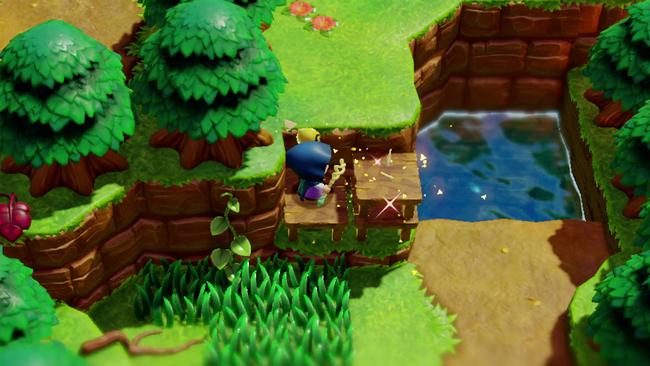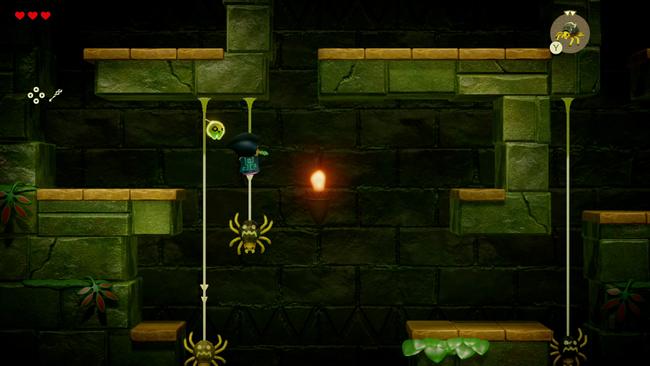
Zelda: Echoes of Wisdom balances creativity, improvisation, & fulfillment to make something special - Preview
When Nintendo revealed The Legend of Zelda: Echoes of Wisdom back in June, there was this immediate undeniable charm to it. Yes, the Princess of Hyrule herself is now taking the center stage as the protagonist and even more important, she had a very distinctive playstyle that separated herself from her trusty knight. I got the chance to go hands-on with this brand-new installment in the Zelda series to see how it all came together.

The demo started off with Zelda escaping from her jail cell and slipping through a few castle guards, since she was suspected of being the catalyst of the rifts popping up throughout Hyrule that has been “stealing away” people. Echoes of Wisdom is quick to introduce its primary titular mechanic - the Echo system. Several objects in the environment will emit a golden light indicating that Zelda can obtain an echo of it; this will allow her to freely make a copy of that object.
Similarly, enemies will drop their echo when Zelda defeats them for the first time; she is effectively a summoner throughout Echoes of Wisdom. When Zelda summons friendly monsters to her side, they will act on their own and will usually try their best to automatically attack surrounding enemies. Locked-on enemies will be prioritized, so there are some ways to influence their behavior.
Echoes do not run out, so once Zelda obtains an echo of something, they’ll stay with her permanently and they can be freely utilized whenever and wherever a person wants. The only limitation to echoes is how much they “cost” in relation to Tri’s power. Tri is Zelda’s companion in Echoes of Wisdom and they make it possible for her to use the echo system in the first place. As far as I've seen in the demo so far, echoes can cost 1, 2, or 3 of Tri’s power though the full game will allow for ways to expand the numerical value of Tri’s power.

For instance, a wooden table takes up one of Tri’s power and that means Zelda can have up to three wooden tables out at once. Players can also choose to summon other “1-cost” items or enemies besides duplicated wooden tables. Instead, they may call upon a Rope snake and a Keese bat since they both only consume one of Tri’s power.
As long as players do not exceed Tri’s power cap, which was 3 in the demo, then they could freely mix and match whatever combination of items and/or monsters at any given time. If Zelda was running low on health for me, I’d have my 2-cost Spear Moblin chuck spears at nearby threats while Zelda slept soundly on a bed she summoned to slowly recover her health.
Even in this early look at Echoes of Wisdom, the system already feels inventive, creative, and flexible. The game wasn’t shy at shoving echoes left and right into the player’s arsenal. How a player handles platforming and combat all lies in how creative they want to be. Battle encounters can be handled with a favorite “team” of synergistic allied creatures or… throwing rocks continuously until a problem ceases to exist.

When it comes to platforming, I could choose to meticulously stack tables and crates to inch closer and closer toward a heightened piece of land. A Skulltula spider echo could also just be a more efficient, alternative method since they’ll fire a web upward immediately upon summoning them, so Zelda can use their web as a climbable rope.
Water physics come into play with echoes, too. Different echoes will interact with the water in different ways; heavier objects will sink, while relatively lighter items float to the surface which can play a factor in how someone chooses to cross a body of water. Do they have echoes that can form a reliable path across it, or perhaps they might even have echoes that can bypass the body of water altogether?
After tinkering with the basics of Echoes of Wisdom at the start of the game, I had the chance to play through a segment that had Zelda dive into a rift and enter the Still World, which was shown off in a recent trailer. All the people, animals, and environments are ostensibly frozen in time and space thanks to the effect of the rift. I made my way across several floating platforms as a result of the rift breaking up parts of the environmental structure of the region until I entered the Suthorn Ruins dungeon.
I was introduced to the previously revealed Bind and Reverse Bond abilities here. Bind allows Tri to latch onto an object or enemy that forms a link between Zelda and whatever Tri has latched onto. Then, whatever movements Zelda performs will also move that object or enemy with her simultaneously. If Zelda and a rock are in a Bind, then moving Zelda to the right will move the rock to the right immediately, as well.
Conversely, Reverse Bond moves Zelda on her own to an already moving object or enemy. If Zelda latches onto a moving platform and activates Reverse Bond, she will move on her own when the platform begins moving in a direction. If Zelda had Bind on the platform instead, then the platform would only move when she moves. This tether dynamic was a recurring theme throughout this dungeon and some clever maneuvering was required to get all the goodies.
Suthorn Ruins was where I obtained a massive 3-cost enemy that was basically a slow-moving knight-in-armor. Though its movements were on the slower side, each swing of its sword was devastating. While its “higher” cost meant it may have had better stats on paper, the lower utility cost of some of my comfortable team compositions felt more valuable to me personally - and that’s the thing, this line of thinking and the perceived solution will be different for everyone.

I even ran into a miniboss that seemed to be some sort of a shadow of Link. Either way, it was hostile and not the Link that we’re all familiar with, and that was a lot of fun experimenting with different teams of monster echoes against it. Plus, players could even utilize the Bind mechanic to have Zelda support her minions. I struck the final blow against this mean not-Link by briefly freezing it with a Bind as I had its attention, while my trusty Spear Moblin threw a spear into his back. I even subconsciously readjusted the position of the boss with Bind, once I saw that the trajectory of the spear toss wasn’t going to initially hit the boss too.
It’s all these little things coming together that are already starting to spark some kind of magic in Echoes of Wisdom for me. There’s a balance of creativity, improvisation, and fulfillment in every step of the way.
This is when I also got to check out the Swordfighter Form for Zelda. To put it succinctly, she’ll well… briefly transform into Link; Zelda even holds the sword with her left hand. A meter slowly drains when she’s in Swordfighter Form but in the duration of this time, people can pretend Link is the protagonist once more for a small amount of time. The meter can be refilled by gathering floating orbs in the Still World segments and the Swordfighter Form can be used anywhere anytime, once Zelda obtains it. Once again, it’s completely up to players to decide when and where they will expend the Swordfighter Mode resources.

The Legend of Zelda: Echoes of Wisdom was such a delight to play. It’s already brimming with potential and the little I’ve seen of it has already impressed me so much. If there’s one thing previous entries in the Zelda franchise have proved to Nintendo, it’s that they shouldn’t be afraid to let players experiment in how they want to play. Echoes of Wisdom continues to build upon that mentality and a new era of zany solutions to a Zelda game is just around the corner when The Legend of Zelda: Echoes of Wisdom releases on September 26 for the Nintendo Switch.